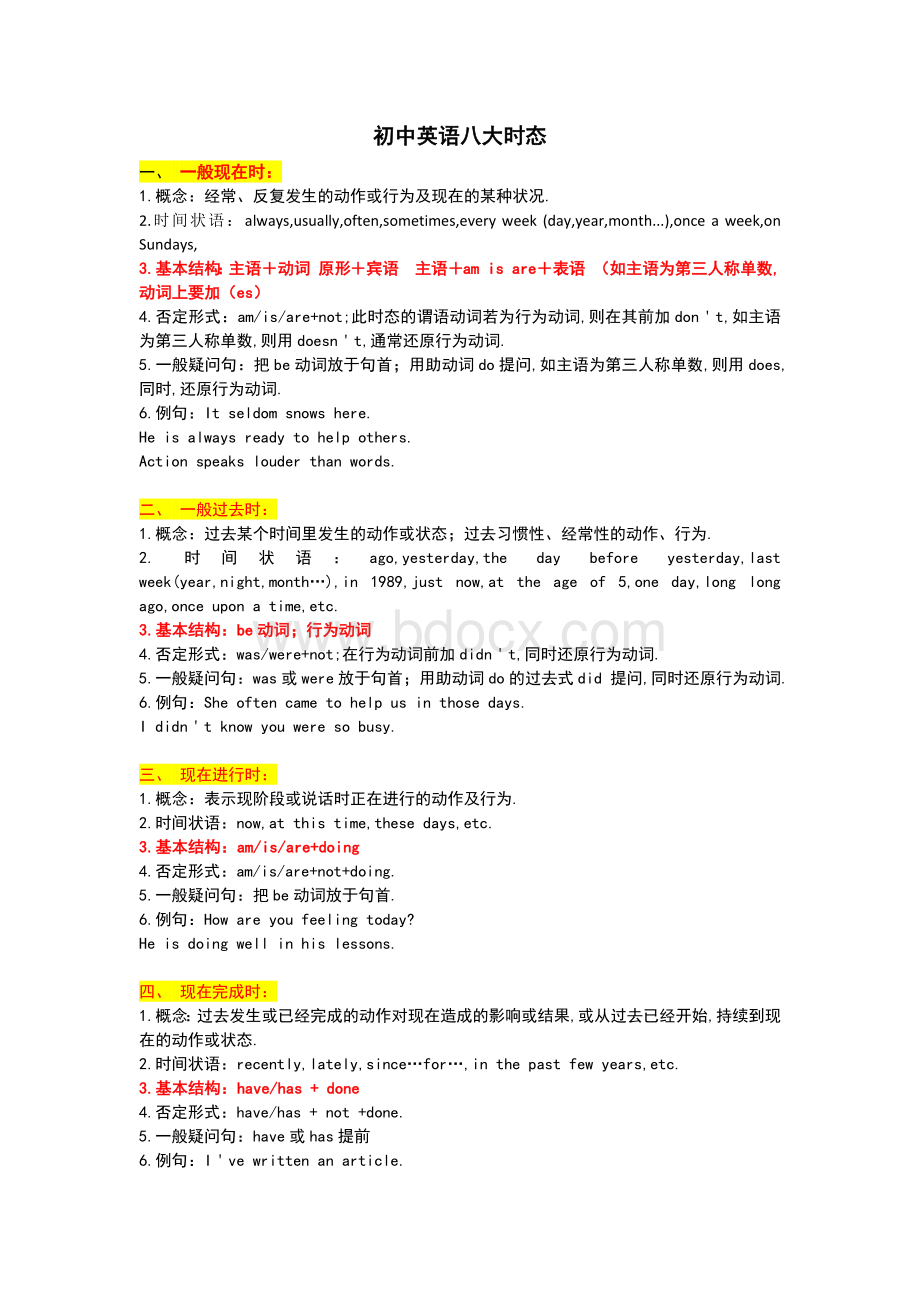初中英语八大时态教案Word文件下载.docx
《初中英语八大时态教案Word文件下载.docx》由会员分享,可在线阅读,更多相关《初中英语八大时态教案Word文件下载.docx(2页珍藏版)》请在冰豆网上搜索。

4.否定形式:
am/is/are+not;
此时态的谓语动词若为行为动词,则在其前加don't,如主语为第三人称单数,则用doesn't,通常还原行为动词.
5.一般疑问句:
把be动词放于句首;
用助动词do提问,如主语为第三人称单数,则用does,同时,还原行为动词.
6.例句:
Itseldomsnowshere.
Heisalwaysreadytohelpothers.
Actionspeakslouderthanwords.
二、一般过去时:
过去某个时间里发生的动作或状态;
过去习惯性、经常性的动作、行为.
2.时间状语:
ago,yesterday,thedaybeforeyesterday,lastweek(year,night,month…),in1989,justnow,attheageof5,oneday,longlongago,onceuponatime,etc.
be动词;
行为动词
was/were+not;
在行为动词前加didn't,同时还原行为动词.
was或were放于句首;
用助动词do的过去式did提问,同时还原行为动词.
Sheoftencametohelpusinthosedays.
Ididn'tknowyouweresobusy.
三、现在进行时:
表示现阶段或说话时正在进行的动作及行为.
now,atthistime,thesedays,etc.
am/is/are+doing
am/is/are+not+doing.
把be动词放于句首.
Howareyoufeelingtoday?
Heisdoingwellinhislessons.
四、现在完成时:
过去发生或已经完成的动作对现在造成的影响或结果,或从过去已经开始,持续到现在的动作或状态.
recently,lately,since…for…,inthepastfewyears,etc.
have/has+done
have/has+not+done.
have或has提前
I'vewrittenanarticle.
Ithasbeenrainingthesedays.
五、一般将来时:
表示将要发生的动作或存在的状态及打算、计划或准备做某事.
tomorrow,nextday(week,month,year…),soon,inafewminutes,by…,thedayaftertomorrow,etc.
am/is/are/goingto+do;
will/shall+do.
was/were+not;
在行为动词前加won't,同时还原行为动词.
be放于句首;
will/shall提到句首.
Theyaregoingtohaveacompetitionwithusinstudies.
Itisgoingtorain.
六、过去进行时:
表示过去某段时间或某一时刻正在发生或进行的行为或动作.
atthistimeyesterday,atthattime或以when引导的谓语动词是一般过去时的时间状语等.
was/were+doing
was/were+not+doing.
把was或were放于句首.
AtthattimeshewasworkinginaPLAunit.
Whenhecamein,Iwasreadinganewspaper.
七、过去完成时:
以过去某个时间为标准,在此以前发生的动作或行为,或在过去某动作之前完成的行为,即“过去的过去”.
before,bytheendoflastyear(term,month…),etc.
had+done.
had+not+done.
had放于句首.
Assoonaswegottothestation,thetrainhadleft.
Bytheendoflastmonth.Wehadreviewedfourbooks
八、过去将来时:
立足于过去某一时刻,从过去看将来,常用于宾语从句中.
thenextday(morning,year…),thefollowingmonth(week…),etc.
was/were/goingtodo;
would/should+do.
was/were/not+goingto+do;
would/should+not+do.
would/should提到句首.
HesaidhewouldgotoBeijingthenextday.
Iaskedwhowasgoingthere.